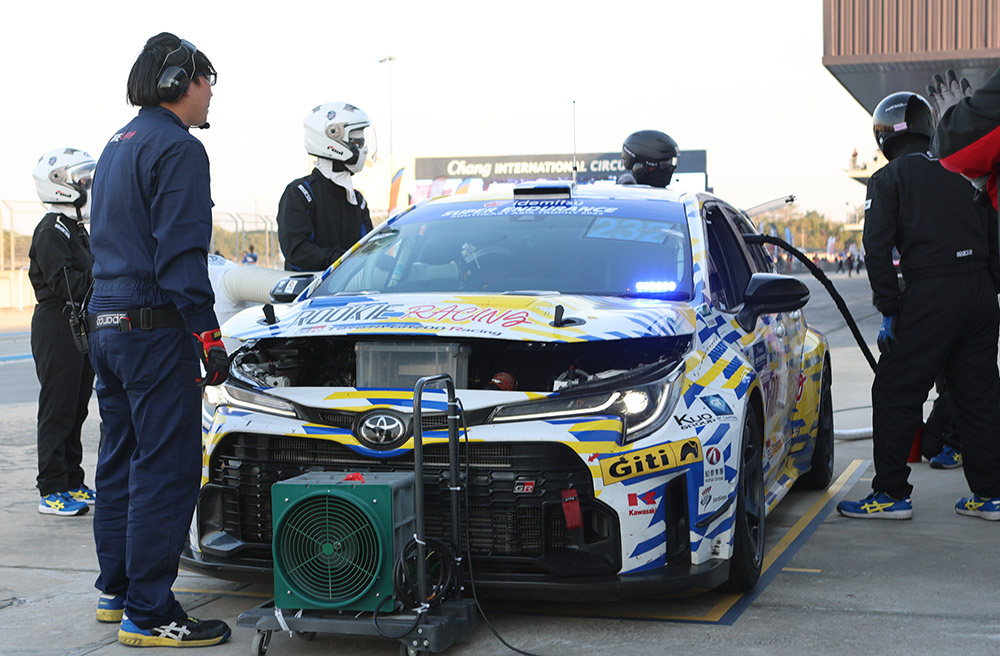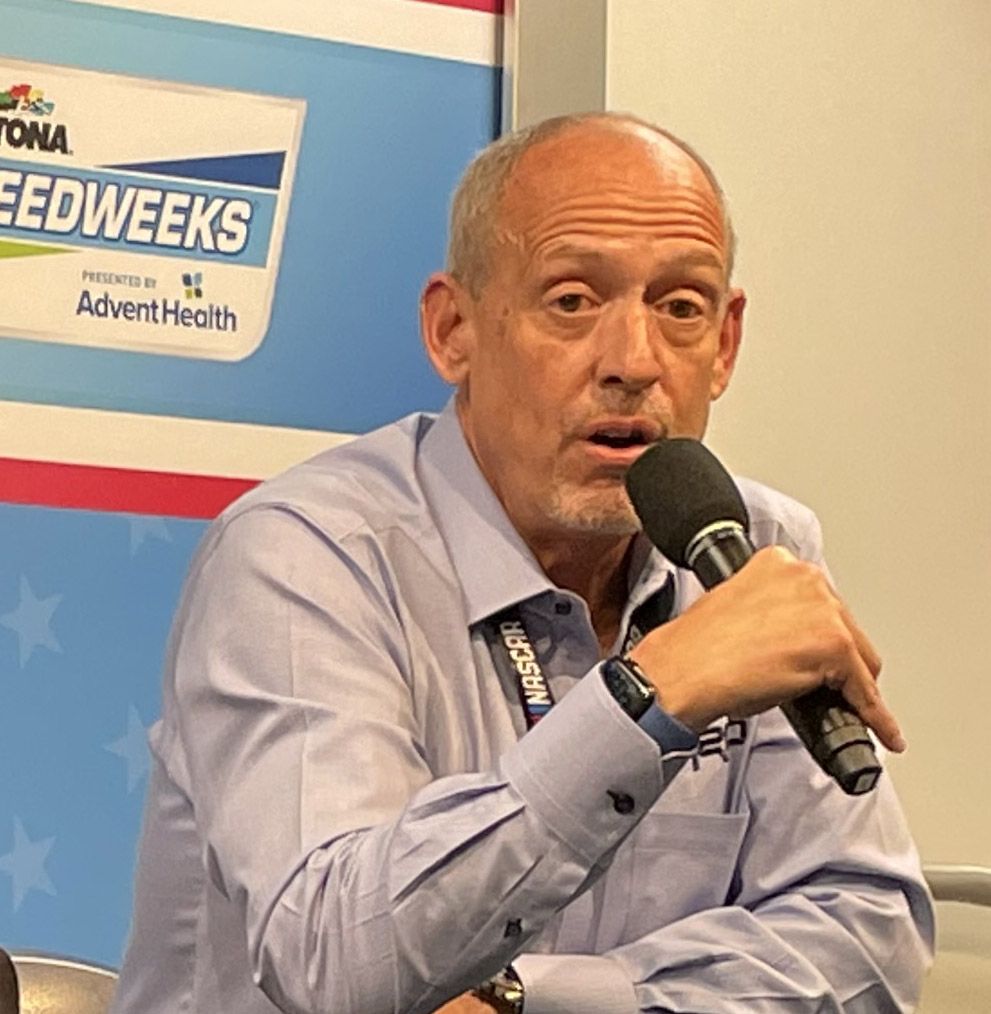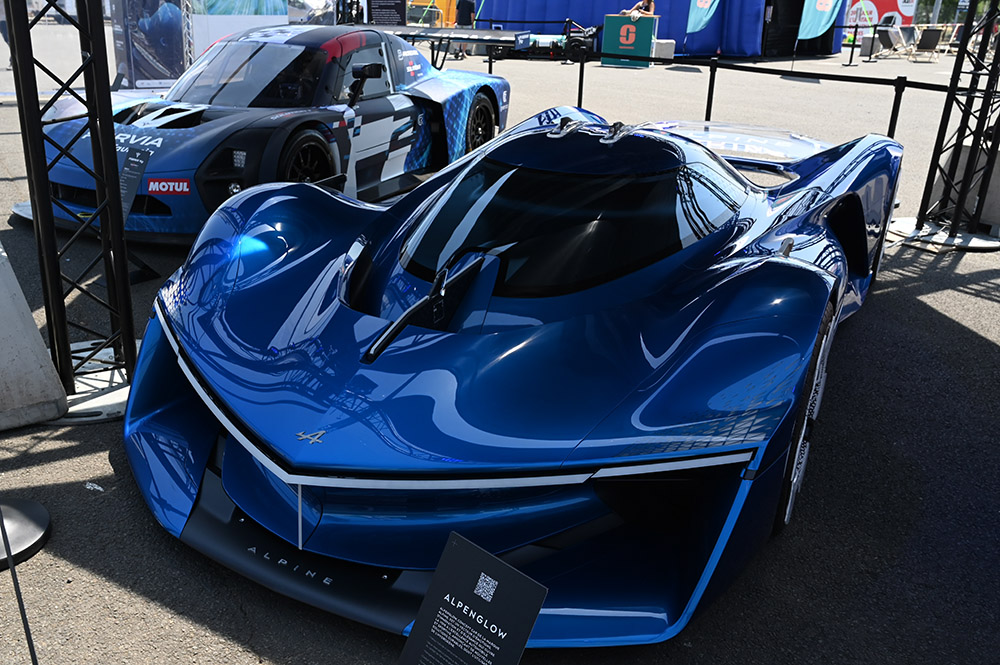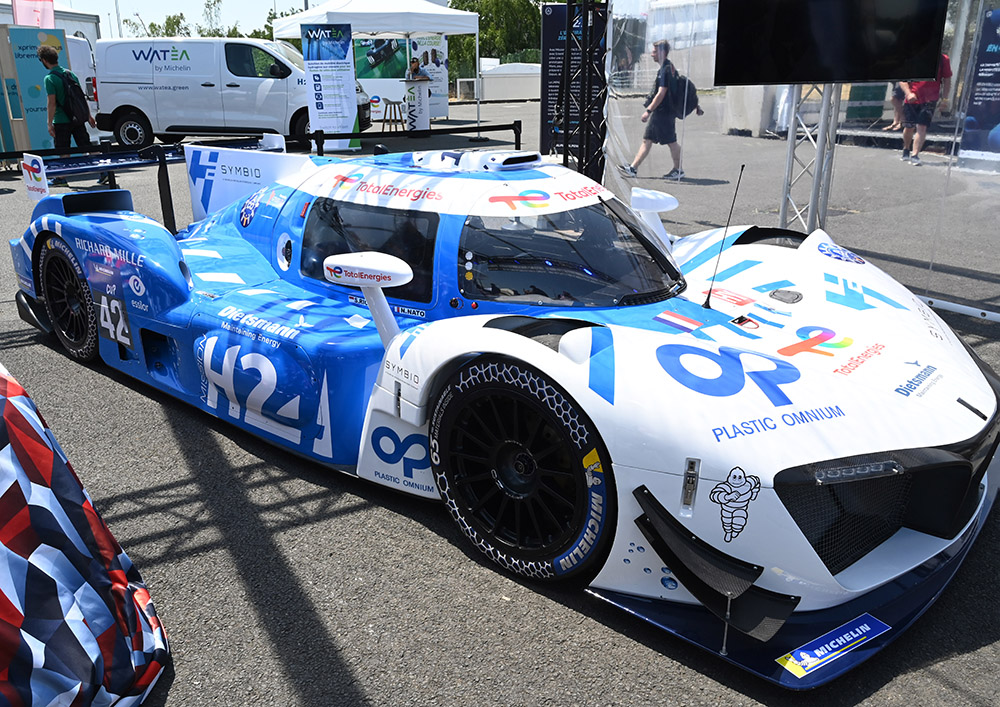By Jerry Jordan, Editor
CONCORD, N.C. – After two years of research, development, testing and fine-tuning, sources confirm NASCAR will debut its EV racecar at the Busch Light Clash in Los Angeles but fans thinking this will be the end of the Cup Series or a transition into “silent runnings” at the racetrack need not panic.
Unlike the electric hum of EV racecars, the hue and cry of fans concerned about EVs pushing internal combustion engine (ICE) racecars out of stockcar racing have not fallen on deaf ears. Sources confirmed to Kickin’ the Tires, which first broke the news of the EV racing program on July 21, 2022, that NASCAR’s primary motivation for creating it is for research and development – stressing, “there is no plan to take the noise out of NASCAR or bring in EV racing as a replacement racing series.”
The idea of an electric vehicle is nothing new and was first put forth as proof of concept in the 1820s followed by Ferdinand Porsche creating his Egger-Lohner C.2 Phaeton in 1898, which reached a whopping 15.53 mph. But that wasn’t good enough and Porsche boosted the power to 22.99 mph just two years later with the Lohner-Porsche Electromobile. Fast-forward 124 years and the world now has electric vehicle options from Porsche, Tesla, Rivian, Toyota, Honda, Chevrolet, Ford, GMC, Audi, Mercedes, Jaguar, Volvo, BMW, Cadillac, Fisker, Mazda, Genesis, Hyundai, Kia, Nissan, Subaru, Polestar, Volkswagen, Mini and Lucid. However, that is just the beginning as Acura, Alfa Romeo, Apple, Bentley and many others are already working on production EVs, so there’s little wonder why NASCAR decided to explore electric powertrain options for racecars.
NASCAR’s electric racecar resembles a small crossover-style passenger vehicle, similar to a rally car like the ones used in Travis Pastrana’s Nitrocross racing events. It was tested in secrecy at zMAX Dragway with mixed results before O’Donnell confirmed it would be tested in December at Martinsville Speedway.
Interestingly, the dates of the Martinsville test were changed from the approximate time given in response to questions about the EV program. The test was also held in secrecy and only a handful of key people were allowed inside the bubble during the two-day event. No media members were invited and security kept everyone from approaching areas of the track or infield where photos or videos might have been captured of the car.
Despite NASCAR’s investment in EV technology for the racing world, it’s not a trailblazer. Other racing series around the world have dipped their toe into the H2O of EV, including all-electric Formula E and Japan’s Super Taikyu Series, which runs a multitude of different powertrain and fuel options in its racing format.
Before the 2023 Cup Series season finale at Phoenix Raceway, NASCAR Chief Operating Officer, Steve O’Donnell confirmed he and other NASCAR officials were heading to Japan to learn more about alternative fuel and powertrain technologies.

Kickin’ the Tires also confirmed that John Probst, NASCAR’s Chief Racing Development Officer, also went to Japan to watch the Super Taikyu Series and to Thailand with O’Donnell, ahead of the 10-hour Idemitsu Super Endurance Southeast Asia Trophy 2023. The goal was to look at other racing series utilizing fuel and powertrain methods to learn how that technology might be used to reduce NASCAR’s carbon footprint, while preserving the sanctity of stock car racing, including the noise factor – something very much lost with EVs.
Probst and O’Donnell attended races that not only included Toyota’s #32 GR Corolla H2 (Hydrogen Gas) Concept car but also the #28 Toyota GR86 CNF (Cellulose Nanofiber) Concept vehicle. The CNF vehicle uses composite construction that is about one-fifth the weight of steel and about five times as strong. This helps reduce the vehicle’s weight and the amount of energy needed to power it, thereby reducing emissions.
NASCAR’s work in the EV sector was no secret to the OEM partners in the garage. Chevrolet, Toyota and Ford all have their own EVs on the showroom floor, although Ford has recently made cuts to its EV program and Toyota is focusing its R&D budgets on multiple options regarding alternative propulsion technologies.
“Clearly, all the OEMs were aware of the mule that was built, the test car, that is what we call a mule in our industry,” said Jim Campbell, Chevrolet V.P. of Performance Vehicles and Motorsports. “What I would just say is that, in racing overall, racing is a place where you can test technologies and innovations and as you test those, some will eventually go forward and some will not. I think what they are doing is they are looking at alternative propulsion technologies to see what will work on the track. It doesn’t mean it is going racing tomorrow, it is a matter of learning, testing and learning. That is a hallmark of racing across all of the series we are in and it is a hallmark of what we do inside the company and an OEM. So, I think you have to keep learning, you have to, and they will learn what works and what doesn’t.”
Campbell explained that Chevrolet uses its involvement in all of the racing series it competes in as a platform to learn, specifically pointing to the eCOPO Camaro, which is a 700-HP electric vehicle, that it tested in the NHRA and “learned a lot.”

“The NHRA worked with us to allow us to do a test run several times and it was interesting and the fans were curious, does it go that fast? That car ran a 9.3 (sec. quarter mile) and a trap speed of 145 mph and I was like, ‘wow, that’s pretty quick,’” Campbell said. “Now, we don’t have an entry that is electric in that series but it is about testing and learning. I think that is a hallmark of racing and that is a hallmark of what OEMs do, you test and you learn.”
With Chevrolet’s and Cadillac’s involvement in the 24 Hours of Le Mans, through the Corvette, Cadillac and Garage 56 programs, Campbell said he saw some of the hydrogen-powered racing vehicles on exhibit at the iconic track in France. He explained he also took a test ride in the hydrogen-powered car developed by the ACO (Automobile Club de l’Ouest), which is the creator and organizer of the 24 Hours of Le Mans.
“When it comes to hydrogen, our company has a big R&D effort into hydrogen and hydrogen technologies, so what I would say for the vehicle you are talking about at Le Mans, I had a chance the year before last to go over and take a test ride in the car that the ACO has developed, which is hydrogen-powered, and we took a full lap around the 8.4-mile track and this car, I rode with a professional driver and I am a pretty big guy, so I was in their pretty tight. I was like a sardine in there and I didn’t know if I could get out once I got in but we were going ten-tenths. This car was incredible – the performance and speed. So, there is potential there. As a company that has an R&D effort in hydrogen, it is certainly something we are working on with what are the applications for production in the showroom and primarily, hydrogen has a big play in the commercial and fleet side of our business. There is a big opportunity there, so we will see what it means for racing. But the whole thing is on the racing platform and as an OEM, testing and learning are critical and we will continue to advocate for that. Where it goes is really that it takes the learning from the testing to see where that goes.”
Regarding hydrogen, there are two types of hydrogen-powered vehicles – one is relatively silent and is essentially the reverse scientific method of electrolysis, mixing hydrogen gas with oxygen from the air to produce electricity and water. The electricity is used to power motors for propulsion and the water is exhausted from the vehicle. It’s an FCEV (Fuel Cell Electric Vehicle) but it is about as silent as a Tesla.
Toyota is heavily invested in hydrogen and utilizes the aforementioned technology; however, the company has also created a method of using hydrogen gas as a fuel supply to power an internal combustion engine. It’s a HICEV (Hydrogen Internal Combustion Engine) and it’s loud.

According to documents on the Toyota press site, “The HICEV concept vehicle is another example that demonstrates Toyota’s commitment to provide a diversity of powertrain options that include conventional Internal Combustion Engines and Hybrid Electric Vehicles (HEVs) in the short-term, and Plug-In Hybrid Electric Vehicles (PHEVs), Fuel Cell Electric Vehicles (FCEVs), Battery Electric Vehicles (BEVs) in the long-term. Powered by hydrogen yet retaining the basic components and architecture of conventional gasoline-powered internal combustion engines (ICEs), Toyota sees HICEV as another potential technology to help reduce carbon, especially in high-performance applications like motorsports, as part of a broader goal to realize a carbon neutral society by 2050.”
It should be noted that Toyota created its first hydrogen-powered vehicle in 1992 and has been working on perfecting the science and the process since that time, according to corporate data. There were several hydrogen concept vehicles created by Toyota, including a modified Toyota Rav4 but it wasn’t until the Mirai debuted in 2015 that Toyota marketed a commercially available hydrogen-powered vehicle.

“Controlling abnormal combustion is the key to hydrogen engines,” said Naoyuki Sakamoto, the Chief Engineer of the project. “The abnormal combustion has the potential to add stress to the engine hardware. Therefore, we developed high-heat parts as well as adjusted the ignition timing and fuel ratio for the Corolla Sport H2 Concept.”
Although Toyota has been criticized by the activist group, Public Citizen, along with other similar groups, for not fully embracing EV battery technology in its overall fleet, Toyota was likely right not to put all of its R&D money into a single alternative fuel idea that has quickly become a liability for automakers, car rental companies and consumers across America and around the world. That said, Toyota is committed to reducing its global carbon footprint and has invested over $13 billion into a battery manufacturing plant in North Carolina.
In a statement on the Toyota website, Akio Toyoda, chairman of Toyota Motor Company, said: “Our ultimate goal is carbon neutrality. BEVs are not the only path towards carbon neutrality. Another way involves using carbon-neutral fuels such as hydrogen and biofuel… having many options for reaching carbon neutrality is important.”
When asked for his input regarding NASCAR’s research into EVs and the potential for a hydrogen-powered racecar with O’Donnell confirming it was an area of interest for the sanctioning body, David Wilson, President of Toyota Racing Development said he understands the thinking.
“It doesn’t matter if it is Formula 1 or NASCAR or sportscar racing, the social and market forces compel every form of motorsport to look at its carbon footprint and NASCAR is no different,” Wilson said. “NASCAR, arguably is a little late to the party but by them announcing NASCAR IMPACT, which looks at the entire footprint when we go to a track, and I think they have set a 2035 goal to be carbon neutral as a sport. I think there are many, many things you can do to attack that besides the racecars on the track. If you compare the carbon that is generated by those 36 cars to the 100,000 people who drive to the track it is inconsequential.

“Yes, we know about the battery-electric car (BEV), we’ve been a party to its development. Toyota’s position is not bullish on battery electric for racing purposes and it is first and foremost because we are in the entertainment business. And I don’t believe there has been a successful battery-electric racing series, yet, and NASCAR, in my opinion, isn’t going to be any different. There are other technologies, as in hydrogen combustion that I think would deliver the best of both worlds – a carbon-neutral footprint and it makes noise. So, the technology is there and the biggest limitation is the sourcing of green hydrogen but with as much resources that are behind it, Toyota is investing a lot in that technology, I don’t think it is that far off.”
Wilson said, Monday, January 23, that Toyota is, “not abandoning the internal combustion engine.”
Just in the past two months in America, the fallout from issues involving total EVs has made the news cycle on a weekly, if not daily, basis. From thousands of people being trapped in their cars with no way to start, or even charge them during recent frigid conditions to Hertz selling off more than 30,000 EVs because no one wants to rent them to automakers pulling back and scrapping future production numbers because of dismal sales, it appears the EV fad is fading fast.
In an exclusive interview, Bill Klehm, CEO of mobility company eBliss Global, told Kickin’ the Tires, investors are putting pressure on companies and lobbyists to take action in Washington D.C. in hopes of delaying or scrapping mandates for EV use and sales requirements. It’s a trend that Klehm, who spent over 13 years at Ford Motor Company before moving on to Visteon and other companies in the automotive sector, said will continue as he believes hydrogen is part of the future of alternative fuels and that specifically, NASCAR is smart to look at different concepts but also in not committing 100 percent to any method of alternative propulsion at this time.
“The automakers have said, ‘enough of this and these pundits in Washington D.C., we are going to make changes because we are going to get punished by our shareholders if we continue down this road at this pace,’” Klehm said. “That’s the reason why they have all decided intelligently to slow this role a little bit and figure out what is going on. Again, the conversion will happen. Hydrogen has a lot of similarities to gasoline in that you will burn it and you will use the raw energy inside a power plant when burn it. And hydrogen, when you burn it, it is oxygen and water, right, so in one way, it is much better for the environment but to get to that benefit there are a million different inventions that have to happen to create a commercial system.
“As I look at the landscape, I’m saying the reality is that you are going to see all of these powerplants come into the marketplace at some level, they are all going to come. You are not going to replace gasoline and diesel with just electricity, effective. It’s not going to happen. You’re not going to replace them with just hydrogen. You are going to have these, what I am going to call ‘use cases’ so the vehicle is going to be used for what, what does the powerplant need to be to satisfy the product market fit for that consumer, for that powerplant? That’s the reality of what we are faced with.
“A long time ago when I was inside Ford, I had the official radiator of NASCAR and I had a motorsports job at Ford in NASCAR, as well, so I’ve been around motorsports a lot of my life. I have probably been to more NASCAR races than should be allowed by law. All of the motorsports guys are, kind of, mimicking the technology path and what the consumers are going to buy and then they would like to integrate that into their motorsports, because again, race on Sunday, sell on Monday. When I think about this, I think about what is really going on in consumer behavior.
“A group of my friends were part of the group that formed Formula E and the number one complaint from customers in Formula E is that there is no noise.”
Klehm explained that on an average day, there are 119 million rides in a car across the U.S. every day and 23 percent of the total number of rides are less than one mile. He believes at some point, consumers and manufacturers will come together on different vehicle technology and won’t need a 3,000- or 4,000-pound vehicle utilizing a “200, 300, 400 or 600 horsepower powerplant” to travel a mile or less. Additionally, 43 percent of all rides each day in the U.S. are less than seven miles. He said once those numbers are realized by consumers it will force change across the automotive industry, which will impact racing and NASCAR is playing it smart. They are essentially looking at the long game in more ways than one.
“The worst two things you can do for an internal combustion engine is one, idle it, and two, drive it a mile. Those are the worst things you can do for them,” Klehm said. “If we did nothing more than convert the 29 million rides that happen one mile at a time … we would save the U.S. consumers $5.3 billion in gas and 4.2 billion tons of carbon would not be emitted into the atmosphere. We need to create vehicles that own the one-mile ride. I think the thing we need to explain to consumers is there are going to be a series of options and you’re going to have some choices and that is the struggle that NASCAR is having. There are no simple answers. It’s going to be really hard. It is not going to be sexy, it’s going to be a lot of math and design and experiment. I guarantee you (NASCAR) is sitting in a room saying, ‘We are in no hurry to do anything, let’s see how this thing shakes out. We have a very successful business here and we are going to stick to what we have in front of us.’”
Although NASCAR began as a regional racing series, it has grown with its reach now stretching from sea to shining sea and its growth potential is global – a fact revealed by the overwhelming fan acceptance of the Garage 56 entry at the 100th Anniversary of the 24 Hours of Le Mans. Although Garage 56 wasn’t an EV, it was a concept car in every way and NASCAR has utilized the information garnered from that program to help improve racing in its current ICE racecars.
“We did Garage 56 to learn and that is why we worked on the EV program, as well,” a NASCAR official said. “But we are looking at a number of different alternative fuel options. This is just a small piece of the research and development we look at as part of our racing commitment to our fans and stakeholders. It is in no way an attempt to replace the racing you see each week at the racetrack.”


This is the worst take I’ve heard and is filled with misinformation about EVs. Their biggest challenge and hurdle we face with EVs is consumer education. I recommend the author spend some time learning about how EVs work. The whole below paragraph I’ve copied is my biggest complaint. I love motorsports but hate those who are trying to push misinformation on others. Charging a vehicle at home is as easy as plugging in your cell phone.
“From thousands (thousands? Please provide a link to the source) of people being trapped in their cars with no way to start(they couldn’t just get out? All current EV doors open even when the vehicle is without power ), or even charge them during recent frigid conditions (I charged at home in 10 degree weather by plugging it in to my outdoor outlet) to Hertz selling off more than 30,000 EVs because no one wants to rent them to automakers pulling back and scrapping future production numbers because of dismal sales, it appears the EV fad is fading fast”- hybrids, plug in hybrids and battery electric vehicles were 15.8% of new US vehicle sales which is up 3% yoy. Additionally EV sales are 7.6% of all new US vehicles an increase of 2% yoy. In Europe EVs accounted for 47% of all new cars sales. A fad decreases in popularity, where EVs are growing in popularity.
EDITOR’S NOTE: So, I wrote the article and it is factually correct. If you would like to debate the merits of the article with me, I am happy to debate you on my new podcast that I am creating for 2024. Come on the show, bring your complaints, be well-armed and see if you can hold up to the same scrutiny. I appreciate your input and response but Hertz is ditching the EVs, Ford is cutting its fleet and removing EVs from dealerships and many, many people in EVs were stranded by the recent frigid temps across the country. I am providing a link to the Google Search results that show multiple news articles from across the country where people’s EVs wouldn’t go. -Jerry Jordan, Editor
https://www.google.com/search?q=thousands+stranded+as+EVs+freeze&rlz=1C1RXMK_enUS1016US1016&oq=thousands+stranded+as+EVs+freeze&gs_lcrp=EgZjaHJvbWUyBggAEEUYOdIBCTEwODkwajBqN6gCALACAA&sourceid=chrome&ie=UTF-8#ip=1
If I had any interest in watching EV racing. I’d get the Tyco set down from the attic.
Two things. I won’t be watching ev races and nothing sponsored by a bud light.
EDITOR’S NOTE: Don’t worry, we are not offended by your comments. EV racing might be interesting but I think H2 (hydrogen) is the future for a lot of racing and the automotive industry. Fun Fact: There is more hydrogen in the universe than any other element. As for Bud Light, it has nothing to do with the controversy surrounding the brand, I am allergic to ALL beer and I don’t drink it because I like breathing. -Jerry Jordan, Editor
Mr. Akio Toyota no longer is its CEO. He stepped down a while ago.
EDITOR’S NOTE: That information came directly from the Toyota Press website and at the time it was written he had not stepped down. He is still Chairman of Toyota.
Nascar now fishly sucks the big Winnie. Succumbed to the woke community of the Biden administration. I will never watch another nascar race you queer boys.
EDITOR’S NOTE: You have absolutely no idea what you are talking about. Market forces are what is making NASCAR look into technology like electric and hydrogen. When the federal government mandates fuel mileage and efficiency standards to reduce carbon emissions for automakers, the only option they have is to do it or go out of business. And they use racing to develop the technologies for their future business operations. Like it or not, the powertrain and propulsion technology for the automotive industry is changing and the only thing NASCAR can do is follow the mandates of the automakers, which spend millions and millions on racing to learn. -Jerry Jordan, Editor
😎 AWESOME article
! ! !
* thank you 🤗
ARE YOU PEOPLE NUTS HOW ARE YOU GOING TO RACE WITH EV CARS .IT TIME TO GET A NEW PRESIDENT TO NASCAR.
I agree that usage is going to play a big factor in the type of vehicle people will be using moving forward. Gasoline ICE will be replaced by a multitude of options that will use alternative fuels and electric technologies. I think it is wise for NASCAR to realize that being at the forefront of technology is the right step forward. This is a big step forward for a racing series that was using ancient technology like a normally aspirated V8 engine a few years ago. (that hasn’t even been used in production vehicles for many years) I believe that alternative fuels (hydrogen or biofuel) for ICE engines and hybrid technology should be the next step utilized in motorsports. These technologies have the easiest route to being commercially viable (in my opinion) and make motorsports a viable test bed for OEMs to invest in.
Hydrogen… Isn’t that very dangerous in a wreck situation?? Carbon is essential to life on earth. Y’all need to get better educated on that. Carbon emissions being too high and global warming is about as real as the Easter bunny. The earth has natural Cycles.
Also if you guys put those little frickin cars on the Track… Your done for. I personally fell in love with NASCAR BECAUSE of the look of the cars. After the horrendous COTs in ’08, it’s went down hill. What’s happening to sports!!
Flag Football in the NFL Pro Bowl, now y’all want ev cars that’s basically the size of a mini Cooper??
Mark my words. This will be the end of NASCAR.
EDITOR’S NOTE: If you know me, I am about as far from a tree hugger as you could possibly be but carbon releases are a real thing. That said, H@ (hydrogen) would be a great fuel alternative. I don’t think there is a grand future for EVs. Remember, in 1878 the British Parliament ridiculed Thomas Edison for the lightbulb saying America could have it but it wasn’t good enough for them. How’d that work out. Research and experimentation are what lead to promising developments. -Jerry Jordan, Editor
I have been arguing in favor or hydrogen ICE vehicles for a few years on The fast Lane Truck.
Stick to your guns. After these many years I finally got a back up.
The biggest complaint was lack of infrastructure
No one believed that electricity had an even bigger infrastructure problem.
And the cheap electricity argument does not play in California.
The hydrogen can be produced at local solar farms using water recycled at local sewage plants.
Hydrogen can be delivered by truck and tanker. It can be delivered by existing natural gas pipeline in a 20/80, mix then separated at a central location.
Then delivered to a Hydrogen filling station.
Lots of people do not have any idea about the advancements in the last 10/20 years.
Both hydrogen EV’S and Battery EV’S have on major problem. Initial cost of the vehicle. A hundred million or more America can not afford them.
The $7500 dollar r
Tell the drivers to wear a fire proof suit.
Stronger than what they wear.
They will need it
I can see it now. Feb ’26…welcome to either The “Daytona 75”. Or , “The 24 Hours Of The Daytona 500”, if you include pit stops.
EDITOR’S NOTE: That’s actually funny but it is highly inaccurate. EVs are not replacing the Cup Series. Any information or speculation to the contrary is just wrong. -Jerry Jordan, Editor
When i was in Germany the cab drivers said they used to drive Hydrogen cars and it was great. I would bet it will be the way to go. Not exactly sure why they went away from it. it would be interesting to look into what happened.
Also,
The rebate does not help a hundred million or more people who don’t have a tax liability, such as the elderly. I planned and saved so that I have a good retirement fund with no tax liability.
This means I will effectively be Paying $7500 more than others for an EV.
Hydrogen has a lot of safety built into it. Have you seen the video of the
Hyndenburg disaster. The hydrogen is lighter than air and rose up away from people fleeing from the wreck. A liquid fuel would fall, spreading and and burning many on the ground. Only about 1/3 of the passengers actually died in that wreck. There are a lot of airplane wrecks with no survivors.
Think of a liquid fuel tanker wreck. Not long ago there was one in San Francisco area. Hundreds of millions in damage and untold millions of costs associated with the required closer of the freeway.
That would not happen with hydrogen.
Hydrogen rises it does not spill into the gutters.
California has had huge solar farm overproduction of electricity. To the point that we have been giving it away to Arizona utilities.
Using this overproduction to produce hydrogen will mean much cheaper hydrogen.
We also need to start thinking of hydrogen as a storage medium.
We keep hearing of a new cheap battery right around the corner.
Hydrogen is already here. We just need to put it to work.
To mention all the advances in hydrogen would require a huge book.
Advances in hydrogen are already here.
The public needs to be educated.
A BEV requires the public to change their way of life.
The hydrogen EV allows the public to continue a lifestyle the have gotten used to.
I am 73 yo.
I can buy a vehicle that gets 40 mpg or more for 19 grand.
I can load that car up with 4 grand kids and take them to Yellostone NP over the Easter vacation. I can be there in 14 hours.
You certainly wouldn’t do that in a EV.
You wouldn’t even dare take a EV across central Nevada on Hyw 6.
With a bit of infrastructure improvement a hydrogen FC vehicle would breeze there just like the ICE vehicle.
Fuel cell vehicles using hydrogen are actually ELECTRIC CARS!!
They use hydrogen in the fuel cell to generate electricity which is locally stored in a small battery and fed to the electric motors. GM is one the world leaders in this technology, having built over 100 fuel cell powered 2009 Chevrolet Equinox test vehicles (do a web search and read about it) and rab them during the 2010 Winter Olympics. So these were actually the first electric SUVs ever made.
But why go through the trouble of storing and pumping hydrogen if the fuel cell vehicles are electric powered? Just replace the fuel cell and H2 tanks with a larger swappable battery and race then as pure electrics!
EDITOR’S NOTE: You are part right and part wrong. There are actually TWO types of H@ (hydrogen) powered vehicles that are available in the market. The first, which is older technology, strips the electrons from the hydrogen to produce electricity that powers an electric motor used for propulsion. The second, which I wrote about in the article, uses hydrogen as a combustible fuel similar to gasoline to power an internal combustion engine. That engine produces a rich sound like a racecar and the only by-product is a little bit of Nox and water vapor. The air brought into the engine to help burn the hydrogen is actually cleaned in the process, which in my opinion is amazing, because you are actually discharging a cleaner emission that you took in during the process. Because of this and several other factors, I predict this hydrogen-powered ICE vehicle will play a significant role in the future of alternative propulsion vehicles. -Thanks, Jerry Jordan, Editor
I suspect that Jim Campbell “rode” in the ACO hydrogen car at LeMans.
You would be correct. I appreciate you pointing out the “one, single error” in my 3,000+ word article. I will try to do better next time but please don’t look too closely, you may find yourself in an editor’s role at KTT if you aren’t careful and the pay sucks. -Jerry Jordan, Editor
Nascar might as well go Bank rup cause no one will want to come.
The Fotmula E races in Europe gets thousands of fans watching the races every year. This race is broadcasted on TV and I have seen them. So you are terribly wrong about ” no one will want to come”. There are thousands of EV fans who will come!
EDITOR’S NOTE: Thousands of fans across a few races in Europe does not equate to hundreds of thousands or even millions of fans spread across 38 NASCAR races each year in America. I would be curious to see what other support series ran with the Formula E group but I do realize some people like that racing. I would argue it is a limited crowd. I would also point out that the world is woefully behind the curve in having adequate energy supplies to support millions of electric vehicles. If someone wants and E-car to drive to the corner market or drop the kids off at school, great. But they are impractical for traversing any extended distance and the offsetting environment factors from battery disposal, production and lithium mining are greater than other alternative propulsion measures already in place. -Thanks, Jerry Jordan, Editor